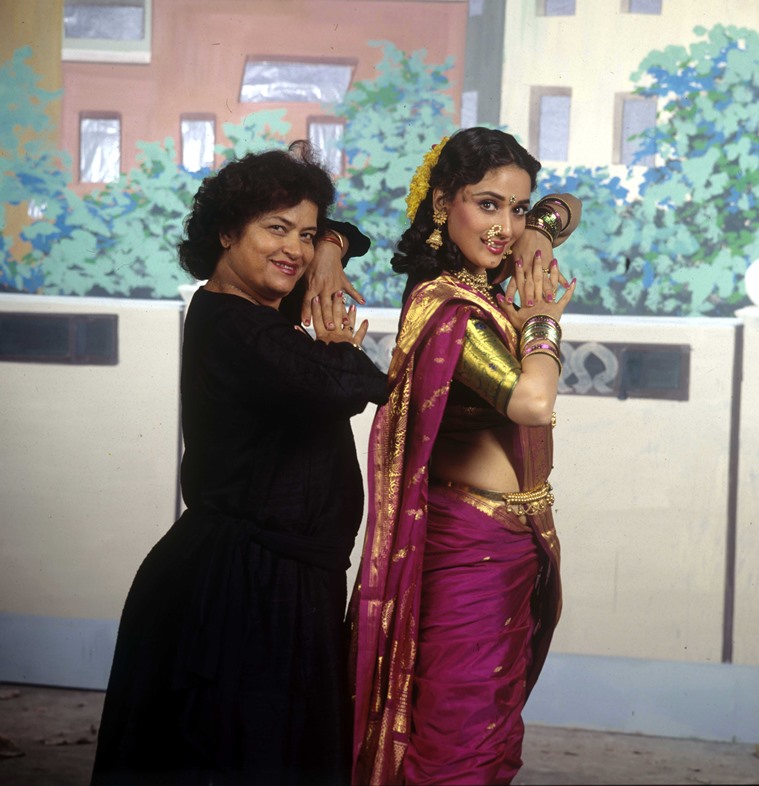 Vinod Mehra, Rishi Kapoor, Sridevi and Saroj Khan on the set of a film. (Express archive photo)
Vinod Mehra, Rishi Kapoor, Sridevi and Saroj Khan on the set of a film. (Express archive photo)
“She was probably the only woman dance director I actually ever met. The year was 1982. She had been praised a lot by Aruna Irani,” says director Subhash Ghai while remembering choreographer Saroj Khan. Ghai worked with Khan on multiple hit songs. Khan, who passed away early on Friday because of cardiac arrest in Mumbai, was instrumental in Ghai getting the title of ‘showman’ given the larger than life song and dance routines that were a staple of many of his films. “I asked her to do one climax song of my film Vidhata (1982) and told her if she proves to be as great a choreographer as Aruna ji claimed, I will give her my next film. She scored and really impressed me during the shoot of the song. I invited her to teach Meenakshi Sheshadri and Jackie Shroff for Hero (1983), which became a huge hit,” adds Ghai.
Khan was born as Nirmala Nagpal in a simple family in Mumbai, her parents had migrated to India from Pakistan after the Partition. She started working at the age of three, as a child actor in the film Nazarana (1961) where she essayed the role of the younger version of actor Shyama. She then continued to be a background dancer. It was her marriage to senior choreographer B Sohanlal, who was thirty years her senior, that she was catapulted into dance as a vocation. Khan learned from Sohanlal, who had choreographed songs for films like Guide (1965), Kaajal (1965), Hare Rama Hare Krishna (1971) and Jewel Thief (1967) among more. Things didn’t work out as Sohanlal was already married and had four children from a previous marriage. Khan then made her debut as an independent choreographer with the Sunil Dutt starrer Geeta Mera Naam in 1974. “But a lesser-known fact remains that she is the one who choreographed the song Hooton pe aisi baat, which she presented to Vyjayanthimala on the sets of Jewel Thief. Saroj Ji told me this story, and that how Vyjayanthimala then said that she would take a week to do the song. Of course, she then came into her own in the early eighties,” shares dancer and actor Jaaved Jaffrey, who worked with Khan in his debut film Meri Jung(1985). “She and my father (actor Jagdeep) were childhood friends. Both started out at the same time. And she was very open to suggestions and improvisations. In fact, in Jawani Zindabad (1990) for the title track, she said to me ‘show me what you got’ and was very open to my suggestions,” adds Jaffrey.
“Saroj Ji was a self-made woman. She had struggled a lot to establish herself, and for a woman to be taken seriously as a dance director. When she started going solo, in the mid-70s, there were no women choreographers. She set the tone for us women choreographers today,” says choreographer Shabina Khan who assisted Khan on Soldier (1998). “I remember we were shooting in New Zealand for a dance sequence with Preity Zinta and Bobby Deol. The crowd had gathered to watch her, and they lined up to take autographs from her. She oozed a star power that rivalled the heroes and heroines.”
 Saroj Khan and Madhuri Dixit on the set of a film. (Express archive photo)
Saroj Khan and Madhuri Dixit on the set of a film. (Express archive photo)
Khan was fondly addressed as Masterji, a title otherwise used for male dance directors. But Khan did everything that a male dance director could do, and then do it better. “Her strength was to make women express themselves freely. She would make them use everything, the neck, eyebrows, head etc. Look at the songs that she has done with Sridevi, Madhuri, you see all the emotions reflected on their faces,” says Jaffrey.
Khan’s choreography was deeply rooted in the traditional dances of India, drawing from both the classical and folk schools. Most of her songs were extravagant, lavish and had a musical, theatrical character to them. It’s only in the mid-nineties with the advent of Farah Khan and Shiamak Davar that Bollywood started to imbibe western-style choreography. “She was a great believer in imparting knowledge. She wanted her legacy to be carried forward. She was a highly private person, and would only want her work to speak for her. She was rarely seen in those typical Bollywood parties, her life was dance, set, rehearsal and then planning a fresh choreography,” adds Shabina Khan who has choreographed for Prem Ratan Than Payo (2015) and Tubelight(2018). “She believed that anyone could dance, and anyone could look pretty while dancing. She was dancing until she was 70. She was famous for calling out stars on the sets and make them do multiple takes. She was quite a taskmaster.”